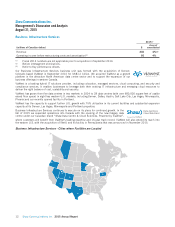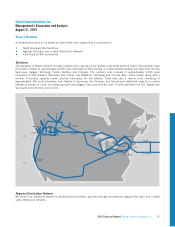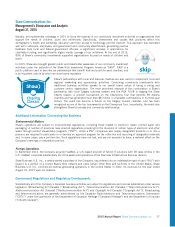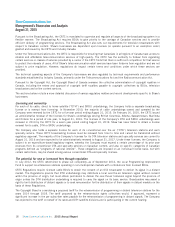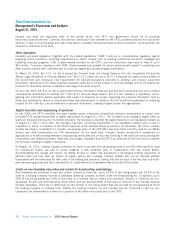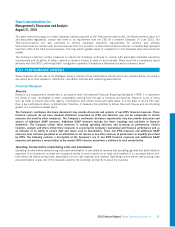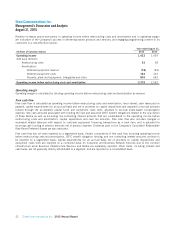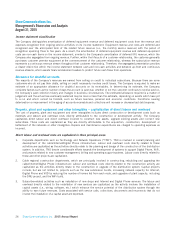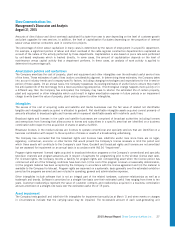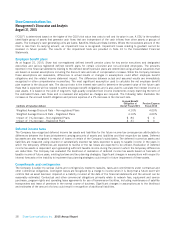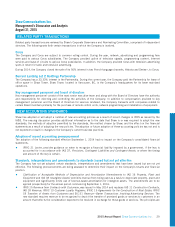Shaw 2015 Annual Report Download - page 22
Download and view the complete annual report
Please find page 22 of the 2015 Shaw annual report below. You can navigate through the pages in the report by either clicking on the pages listed below, or by using the keyword search tool below to find specific information within the annual report.Shaw Communications Inc.
Management’s Discussion and Analysis
August 31, 2015
Canada, and what the respective roles of the private sector, the CRTC and government should be in providing
telecommunications services. Currently, the national contribution fund overseen by the CRTC provides subsidies for local phone
services in high cost serving areas and video relay service. Canadian telecommunications service providers, including Shaw, are
required to contribute to the fund.
Other legislation
Canada’s anti-spam legislation (together with the related regulations “CASL”) sets out a comprehensive regulatory regime
regarding online commerce, including requirements to obtain consent prior to sending commercial electronic messages and
installing computer programs. CASL is administered primarily by the CRTC, and non-compliance may result in fines of up to
$10 million. To ensure compliance with CASL, Shaw reviewed and updated its current practices with respect to marketing and
other communications with customers and its practices regarding computer program installations.
On March 10, 2015, Bill C-13, An Act to amend the Criminal Code, the Canada Evidence Act, the Competition Act and the
Mutual Legal Assistance in Criminal Matters Act (“Bill C-13”) came into force. Bill C-13 expands the lawful access powers of
the Government and introduces new requirements for telecommunications providers to preserve and produce subscriber
information. Almost all of the newly proposed measures under Bill C-13 are subject to judicial oversight and do not require the
provision of information without a warrant or discharge of a burden of proof.
On June 18, 2015, Bill S-4, An Act to amend the Personal Information Protection and Electronic Documents Act and to make a
consequential amendment to another Act” (“Bill S-4”) received Royal Assent. Bill S-4 will introduce a mandatory record-
keeping and notification system applicable with respect to breaches of privacy respecting the personal information held by
Shaw, and penalties for failure to comply with these new requirements. In addition, Bill S-4 modifies the standard for obtaining
consent for the collection, use and retention of personal information, creating a higher burden for organizations.
Digital transition and repurposing of spectrum
In July 2009, the CRTC identified the major markets where it expected conventional television broadcasters to convert their
full-power OTA analog transmitters to digital transmitters by August 31, 2011. The conversion from analog to digital freed up
spectrum for government auction to mobile providers. The Company completed the digital transition in all mandatory markets as
of August 31, 2011. Since then, the Company has been converting transmitters in non-mandatory markets with a view to
completion in 2016, a condition of the CRTC’s approval of the Canwest Global acquisition. On December 18, 2014, Industry
Canada launched a consultation to consider repurposing some of the 600 MHz spectrum band currently used by our Media
division and other broadcasters for OTA transmission. At the same time, Industry Canada introduced a moratorium on
applications to modify existing television broadcasting certificates and on any new licensing in the spectrum band pending the
consultations and related processes. Shaw has, accordingly, requested from the CRTC an extension of the time line to complete
the full slate of analog to digital conversions.
On August 14, 2015, Industry Canada confirmed its intent to proceed with repurposing some of the 600 MHz spectrum band
for commercial mobile use and to jointly establish a new allotment plan in collaboration with the United States.
Accommodating this change will require our Media division to install new equipment or reconfigure existing equipment at
affected sites and may have an impact on signal quality and coverage. Industry Canada has not yet decided whether
broadcasters will be reimbursed for their costs of facilitating this transition, stating that this decision is the first step in a multi-
year repurposing process and that consideration of compensation to broadcasters was not a part of this phase.
Limits on non-Canadian ownership and control for broadcasting undertakings
Non-Canadians are permitted to own and control, directly or indirectly, up to 33.3% of the voting shares and 33.3% of the
votes of a holding company that has a subsidiary operating company licensed under the Broadcasting Act. In addition, up to
20% of the voting shares and 20% of the votes of a licensee may be owned and controlled, directly or indirectly, by non-
Canadians. As well, the chief executive officer (CEO) and not less than 80% of the board of directors of the licensee must be
resident Canadians. There are no restrictions on the number of non-voting shares that may be held by non-Canadians at either
the holding company or licensee level. Neither the holding company nor the licensee may be controlled in fact by non-
Canadians, the determination of which is a question of fact within the jurisdiction of the CRTC.
20 Shaw Communications Inc. 2015 Annual Report




